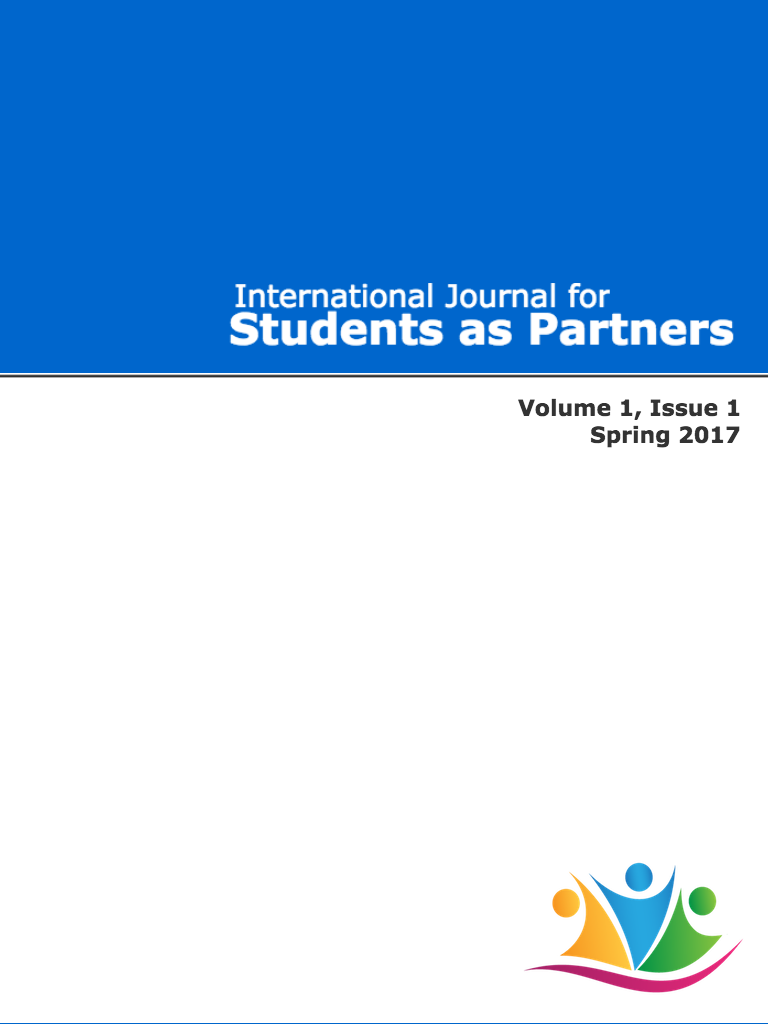Extracurricular Partnerships as a Tool for Enhancing Graduate Employability
DOI:
https://doi.org/10.15173/ijsap.v1i1.3052Keywords:
students as partners, scholarship of teaching and learning, intern, public engagement, employabilityAbstract
The world of work is changing rapidly, with an increasing global demand for employees with higher-level skills. Employees need to have the right attitudes and aptitudes for work, possess work-relevant skills, and have relevant experience. Whilst universities are embedding employability into their curricula, partnerships outside of the taught curriculum provide additional, largely untapped, opportunities for students to develop these key skills and gain valuable work experience. Two extracurricular partnership opportunities were created for Bioscience undergraduates at the University of Leeds, UK: an educational research internships scheme, where students work in partnership with fellow students and academic staff on on-going educational projects, and Pop-Up Science, a unique, student-led public engagement volunteer scheme. Both schemes generate substantial benefits for all. They enhance student’s skills and employability, facilitate and enhance staff-student education practices and research, and engage the public with research in the Biosciences. Collectively, they demonstrate the extraordinary value and benefits accrued from developing extracurricular partnerships between students, staff, and the community.
Downloads
References
Castell, S., Charlton, A., Clemence, M., Pettigrew, N., Pope, S., Quigley, A., Shah, J.N., & Silman, T. (2014). Public attitudes to science 2014.
Ipsos Mori Social Research Institute Report. Retrieved from www.ipsos-mori.com/Assets/Docs/Polls/pas-2014-main-report.pdf
CBI & Pearson. (2015). Inspiring growth: The education and skills survey 2015. Retrieved from www.cbi.org.uk/insight-and-analysis/inspiring-growth-the-education-and-skills-survey-2015/
CBI & Pearson. (2016). The right combination: CBI/Pearson education and skills survey 2016. Retrieved from www.cbi.org.uk/cbi-prod/assets/File/pdf/cbi-education-and-skills-survey2016.pdf
CBI & Universities UK. (2009). Future fit: Preparing graduates for the world of work (Report). Retrieved from www.universitiesuk.ac.uk/policy-and-analysis/reports/Documents/2009/future-fit-preparing-graduates-for-the-world-of-work.PDF
Cook-Sather, A. (2014). Student-faculty partnership in explorations of pedagogical practice: A threshold concept in academic development. International Journal for Academic Development, 19(3), 186-198.
Cook-Sather, A., Bovill, C., & Felten, P. (2014). Engaging students as partners in teaching and learning: A guide for faculty. San Francisco: Jossey-Bass.
Crawford, K., Horsley, R., Hagyard, A., & Derricot, D. (2015). Pedagogies of partnership: What works? (Report). Retrieved from www.heacademy.ac.uk/system/files/pedagogies-of-partnership_0.pdf
Gibbs, G. (1988). Learning by doing: A guide to teaching and learning methods. London: Further Education Unit. Retrieved from http://gdn.glos.ac.uk/gibbs/index.htm
Healey, M., Flint, A., & Harrington, K. (2014). Engagement through partnership: Students as partners in learning and teaching in higher education. York: Higher Education Academy. Retrieved from https://www.heacademy.ac.uk/engagement-through-partnership-students-partners-learning-and-teaching-higher-education
Healey, M., Flint, A., & Harrington, K. (2016). Students as partners: Reflections on a conceptual model. Teaching & Learning enquiry, 4(2), 1-13. Retrieved from http://tlijournal.com/tli/index.php/TLI/article/view/105
Higher Education Academy. (2015). Framework for student engagement through partnership. Retrieved from www.heacademy.ac.uk/enhancement/frameworks/framework-student-engagement-through-partnership
High Fliers Research. (2017). The Graduate Market in 2017. Retrieved from www.highfliers.co.uk/download/2017/graduate_market/GMReport17.pdf
Kuh, G. D. (2008). High-impact educational practices: What they are, who has access to them, and why they matter. Washington, D.C.: Association of American Colleges and Universities. Retrieved from http://provost.tufts.edu/celt/files/High-Impact-Ed-Practices1.pdf
Lewis, D. I. (n.d.). Rethinking Final Year Projects and Dissertations: Creative Honours and Capstone Projects. Retrieved from https://web.archive.org/web/20150305152342/http://insight.glos.ac.uk/tli/activities/ntf/creativehops/examples/Documents/David%20Lewis.docx
Lewis, D. I. (2014a). ETRIS: Facilitating research and training in in-vivo pharmacology. Pharmacology Matters, 7(3), 26. Retrieved from https://www.bps.ac.uk/BPSMemberPortal/media/BPSWebsite/Library/PM-December2014.pdf?ext=.pdf
Lewis, D. I. (2014b). Enhancing employability and building bridges: Evaluation of public engagement opportunities within undergraduate STEM curricula. Retrieved from http://www.srhe.ac.uk/downloads/Lewis.pdf
Lewis, D.I., Byrne, A., Choppin, C., Davies, D., Watkins, C., Chakrabarty, S., McBurney, S., Volz, V., & Wilshaw, S. (2015). Creating Xerte e-learning resources: An easy to use student guide. Retrieved from https://store.data.alpha.jisc.ac.uk/#/resource/8467.
Lewis, D. I., Gutoreva, A., Carlisle, L., Hughes, E., & Black, L. (2014). Enhancing employability and building bridges: Public engagement opportunities within STEM undergraduate degree programmes. Proceedings of the Physiological Society, 31, C75. Retrieved from http://www.physoc.org/proceedings/abstract/Proc%20Physiol%20Soc%2031C75
Marquis, E., Puri, V., Wan, S., Ahmad, A., Goff, L., & Knorr, K. (2015). Navigating the threshold of student-staff partnerships: A case study from an Ontario teaching and learning institute. International Journal for Academic Development, 21(1), 4-15. doi: 10.1080/1360144X.2015.1113538
Oden, M., Mirabal, Y., Epstein, M., & Richards-Kortum, R. (2010). Engaging undergraduates to solve global health challenges: A new approach based on bioengineering design. Annals of Biomedical Engineering, 38(9), 3031-3041.
Pauli, R., Raymond-Barker, B., & Worrell, M. (2016). The impact of pedagogies of partnership on the student learning experience in UK higher education. York: Higher Education Academy. Retrieved from www.heacademy.ac.uk/resource/impact-pedagogies-partnership-student-learning-experience-uk-higher-education
Sanders, J., & Higham, L., (2012). The role of higher education students in widening access, retention and success: A literature synthesis of the Widening Access, Student Retention and Success National Programmes Archive. York: Higher Education Academy. Retrieved from www.heacademy.ac.uk/system/files/wasrs_sanders.pdf
Spurring, E., Bacon, A., Garrod, F. L., & Lewis, D. I. (2014). Pop-Up Science: A student-led public engagement volunteer scheme. Proceedings of the Physiological Society, 31, C73. Retrieved from http://www.physoc.org/proceedings/abstract/Proc%20Physiol%20Soc%2031C73
Stone, B. (2015). Engaged Learning Sheffield: Co-production and community in education at the University of Sheffield. Sheffield: University of Sheffield. Retrieved from www.sheffield.ac.uk/polopoly_fs/1.521092!/file/EngagedLearningSheffield.pdf
Stone, B. (2016). Facing outwards: Engaged Learning at the University of Sheffield. Sheffield: University of Sheffield. Retrieved from www.sheffield.ac.uk/polopoly_fs/1.661883!/file/FacingOutwards.pdf
Downloads
Published
How to Cite
Issue
Section
License
Copyright (c) 2017 Author

This work is licensed under a Creative Commons Attribution 4.0 International License.
Authors retain copyright and grant the journal right of first publication with the work simultaneously licensed under a Creative Commons Attribution License that allows others to share the work with an acknowledgement of the work's authorship and initial publication in this journal.
Authors are able to enter into separate, additional contractual arrangements for the non-exclusive distribution of the journal's published version of the work (e.g., post it to an institutional repository or publish it in a book), with an acknowledgement of its initial publication in this journal.
Authors are permitted to post their work online (e.g., in institutional repositories or on their website) prior to and during the submission process - this applies to the submitted, accepted, and published versions of the manuscript. This can lead to productive exchanges, as well as earlier and greater citation of published work (see The Effect of Open Access).


